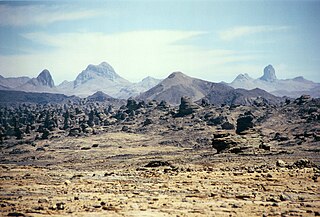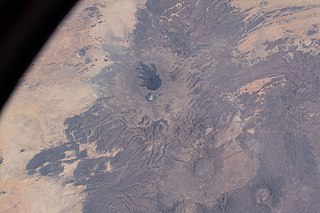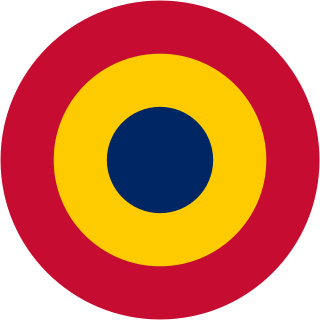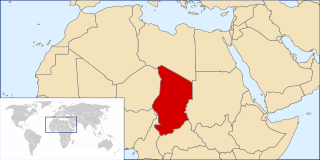
The Tibesti Mountains are a mountain range in the central Sahara, primarily located in the extreme north of Chad, with a small portion located in southern Libya. The highest peak in the range, Emi Koussi, lies to the south at a height of 3,415 meters (11,204 ft) and is the highest point in both Chad and the Sahara. Bikku Bitti, the highest peak in Libya, is located in the north of the range. The central third of the Tibesti is of volcanic origin and consists of five volcanoes topped by large depressions: Emi Koussi, Tarso Toon, Tarso Voon, Tarso Yega and Toussidé. Major lava flows have formed vast plateaus that overlie Paleozoic sandstone. The volcanic activity was the result of a continental hotspot that arose during the Oligocene and continued in some places until the Holocene, creating fumaroles, hot springs, mud pools and deposits of natron and sulfur. Erosion has shaped volcanic spires and carved an extensive network of canyons through which run rivers subject to highly irregular flows that are rapidly lost to the desert sands.

FROLINAT was an insurgent rebel group active in Chad between 1966 and 1993.

Bardaï is a small town and oasis in the extreme north of Chad. It is the main town of the Tibesti Region, which was formed in 2008 from the Tibesti Department of the former Bourkou-Ennedi-Tibesti region.

The Chadian Air Force is the aviation branch of the Chad National Army. It was formed in 1961 as the Chadian National Flight/Squadron.
Movement for Democracy and Justice in Chad is a Chadian rebel group that tried to oust the government of the current Chadian president Idriss Déby from October 1998–2003. The movement was founded by Youssouf Togoïmi, Déby's former Defense Minister, and operated primarily in Bourkou-Ennedi-Tibesti and the Tibesti Mountains.
The People's Armed Forces was a Chadian insurgent group composed of followers of Goukouni Oueddei after the schism with Hissène Habré in 1976. With an ethnic base in the Teda clan of the Toubou from the Tibesti area of northern Chad, the force was armed by Libya and formed the largest component of the Transitional Government of National Unity (GUNT) coalition army opposing Habré. FAP troops rebelled against their Libyan allies in the latter part of 1986. Many of them were subsequently integrated into the national army, the Chadian National Armed Forces (FANT), and participated in the 1987 attempt to drive Libya out of Chadian territory.
Youssouf Togoïmi was a Chadian politician who served in the government under President Idriss Déby but subsequently led a rebel group, the Movement for Democracy and Justice in Chad (MDJT), against Déby.
Acyl Ahmat Akhabach (1944–1982) was a Chadian Arab rebel leader during the First Chadian Civil War. He was the head of the Democratic Revolutionary Council until his death in 1982, and served as the foreign minister of Chad under Goukouni Oueddei's government.
The Volcan Army was a Chadian insurgent rebel group that was active during the First Chadian Civil War. The movement was founded in 1970 by Chadian Arab insurgent leader Mohamed Baghlani, who had been expelled in June from the FROLINAT by the organization's secretary-general Abba Siddick. The new group was islamist and mainly composed of Arabs who shunned Siddick's leadership of the FROLINAT; it was based in Libya. For several years, until about 1975, the Volcan Army had little force on the ground, but after that it slowly expanded. Among the new members in 1976, Ahmat Acyl who attacked Baghlani's authority with the support of Libya in January 1977. When Baghlani died in a car accident in Benghazi on March 27, Acyl became the new leader of the militia with the full support of the Libyan leader Muammar al-Gaddafi, and Acyl became his most loyal man in Chad.

The Chadian–Libyan War was a series of military campaigns in Chad between 1978 and 1987, fought between Libyan and allied Chadian forces against Chadian groups supported by France, with the occasional involvement of other foreign countries and factions.

The National and Nomadic Guard of Chad is one of five defence and security forces in Chad. Article 200 of the Constitution of 1996 states that the duties of the GNNT are the protection of politicians, government officials, and government buildings; the maintenance of order in rural areas; and the guarding of prisons and prisoners. These responsibilities remain unchanged in the new Constitution of 2018 but are now in Article 195.

Oueddei Kichidemi was the father of the former Chadian President Goukouni Oueddei and was the tribal leader, or derde, of the Toubou Teda of the Tibesti during the First Chadian Civil War.
Opération Bison was a French military operation in Chad from 1969 to 1972.

The Toyota War, also known as the Great Toyota War, which took place in 1987 in Northern Chad and on the Chad–Libya border, was the last phase of the Chadian–Libyan War. It takes its name from the Toyota pickup trucks, primarily the Toyota Hilux and the Toyota Land Cruiser, used to provide mobility for the Chadian troops as they fought against the Libyans, and as technicals. The 1987 war resulted in a heavy defeat for Libya, which, according to American sources, lost one tenth of its army, with 7,500 men killed and US$1.5 billion worth of military equipment destroyed or captured. Chadian forces suffered 1,000 deaths.

The Capture of Kufra was part of the Allied Western Desert Campaign during the Second World War. Kufra is a group of oases in the Kufra District of south-eastern Cyrenaica in the Libyan Desert. In 1940, it was part of the colony of Italian Libya Libia Italiana, which was part of Africa Settentrionale Italiana (ASI), which had been established in 1934. With some early assistance from the British Long Range Desert Group, Kufra was besieged from 31 January to 1 March 1941 by Free French forces which forced the surrender of the Italian and Libyan garrison.
Chad achieved independence in 1960. At the time, it had no armed forces under its own flag. Since World War I, however, southern Chad, particularly the Sara ethnic group, had provided a large share of the Africans in the French army. Chadian troops also had contributed significantly to the success of the Free French Forces in World War II. In December 1940, two African battalions began the Free French military campaign against Italian forces in Libya from a base in Chad, and at the end of 1941, a force under Colonel Jacques Leclerc participated in a spectacular campaign that seized the entire Fezzan region of southern Libya. Colonel Leclerc's 3,200-man force included 2,700 Africans, the great majority of them southerners from Chad. These troops went on to contribute to the Allied victory in Tunisia. Chadians, in general, were proud of their soldiers' role in the efforts to liberate France and in the international conflict.
The National Union for Independence and Revolution was the ruling party in Chad between 1984 and 1990. It was founded in June 1984 by President Hissène Habré as a successor of his Armed Forces of the North, the insurgent group through which Habré had conquered power in 1982. The party was banned six years later by Idriss Déby when he assumed power by overthrowing Habré in the 1990 coup d'état.

The Chadian Civil War of 1965–1979 was waged by several rebel factions against two Chadian governments. The initial rebellion erupted in opposition to Chadian President François Tombalbaye, whose regime was marked by authoritarianism, extreme corruption, and favoritism. In 1975 Tombalbaye was murdered by his own army, and a military government headed by Félix Malloum emerged and continued the war against the insurgents. Following foreign interventions by Libya and France, the fracturing of the rebels into rival factions, and an escalation of the fighting, Malloum stepped down in March 1979. This paved the way for a new national government, known as "Transitional Government of National Unity" (GUNT).

Tibesti Region is a region of Chad, located in far northwest of the country. Its capital is Bardaï. It was created in 2008 when the former Borkou-Ennedi-Tibesti Region was split into three, with the Tibesti Department becoming the Tibesti Region. The region is named for the Tibesti Mountains, one of the most prominent mountain chains in the Sahara Desert. Tibesti is the least populated region of Chad, and also has the lowest GDP in the country.











